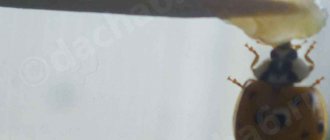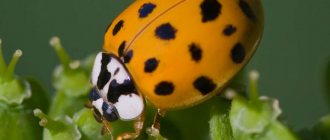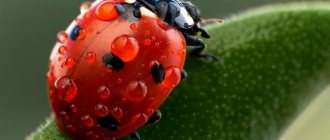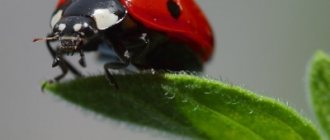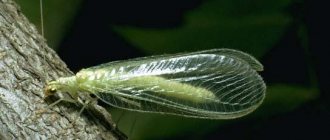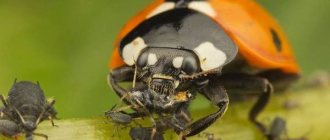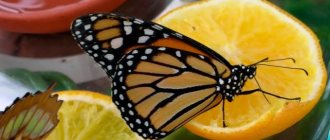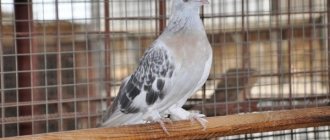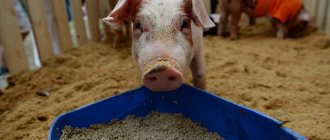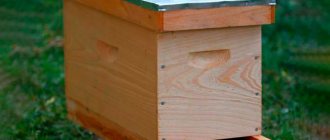- April 5, 2019
- Tips for tourists
- Elena Motrenko
The ladybug is one of those insects that people find attractive. Children especially like these creatures. This insect is common in all countries of the world. It is very difficult to confuse a ladybug with other beetles due to its unusual coloring. But oddly enough, we don’t know as much about her as we think. In this article we will take a closer look at this cute insect and find out what ladybugs eat.
Name
People's positive attitude towards the ladybug is also reflected in the name given to the insect. The epithet “God’s” in its name is present in many countries. Catholics call the insect ladybird or ladubug. At the same time, lady means in this case the Virgin Mary. That is, the ladybug is, in their understanding, an insect of the Mother of God. Translated from French, the name of this animal means “chicken of God.” In other countries of the world, the insect is called no less poetically. Translated from many languages, it usually means some animal belonging to God.
According to popular beliefs, a ladybug descends from heaven and brings goodness with it. This insect has always been treated as a holy creature, killing which was considered a sin.
Life cycle of ladybugs
During the spring and summer months, the ladybug eats enough food and accumulates reserves for wintering. As soon as the cold weather sets in, these beetles begin to hibernate, and in the spring a new round of life begins, and those ladybugs that were able to survive the winter begin to lay larvae, but by the time the new generation reaches full life, these individuals are already dying. However, ladybugs have a very large population, so in nature we meet them quite often, both in the forest and in the concrete jungle of megacities.
In scientific books they are called “Coccinellidae”, or “Coccinellidae”, in other countries the ladybug is called differently: “St. Virgin Mary’s beetle”, “St. Anthony’s beetle”, “Sun”. In Tajikistan they are called “Redbeard Grandfather”. This name shows how sensitive gardeners are to beneficial insects.
Description
Perhaps this is the most famous representative of beetles for both adults and children. There are few people who would not know what a ladybug looks like.
This insect has a round body. It is convex on top and flat on the bottom. The most common ladybugs in nature are red and yellow with black spots on their backs. But these are not all types. There are about four thousand of them in total. Ladybug also comes in black, blue, cyan and other colors.
Instead of dots on her back, she may have stripes and even patterns that resemble letters.
Bright coloring is necessary for the ladybug to protect itself from predators. If this insect gets caught in a spider's web, it has a chance of salvation, since the enemy himself tries to get rid of such a captive by breaking his own trap.
The ladybug has a pair of wings with which it can fly. They are protected by a pair of elytra located on top.
There is a pair of black antennae on the head. The ladybug has three pairs of long legs. A liquid with an odor is released from their folds when the insect senses danger. Ladybug has the ability to play dead if something threatens her. She falls on her back and presses her paws.
What does a ladybug eat in winter?
In winter, ladybugs do not feed on anything, as they hibernate or go into a state of suspended animation. Before winter, ladybugs accumulate glycerin and sugar in their tissues, and also remove large amounts of water from the body, so that when cold weather sets in and the body cools, they do not burst from the temperature change.
With the onset of cool days, insects begin to look for warm places to winter. Ladybugs can concentrate in large numbers in one place for the winter. Before wintering, insects fly in flocks over the city in search of a new shelter. Most often, ladybugs remain for the winter in heaps of dry leaves, in bark, under stones, in forests, in window cracks, sometimes organizing huge clusters. There are often cases when ladybugs fly into private houses and apartments, hide in window frames, behind curtains, behind baseboards and in other inconspicuous places, and then the owners find them in a sluggish state of winter suspended animation.
Ladybugs are very useful: they themselves and their larvae feed on pests - aphids. So if ladybugs decide to spend the winter in your garden plot, you can be sure that in the summer you will be protected from aphids in your garden. But do not rush to completely plow the area, otherwise you will lose your defenders from aphids for a long time. For this small predator, only the human hand is dangerous; they die en masse from the poisons that gardeners spray their gardens with. Therefore, leave a few places with fallen leaves so that the cows have a place to hide and survive the winter.
The ladybug has wings and is a flying insect; among them there are breeds that are called “migratory”. They are like birds; they can fly away for the winter away from their feeding area. But naturally, they hibernate there too, only in huge groups, sometimes even weighing several tons.
Habitat
The ladybug can be found anywhere in the world except Antarctica and permafrost zones. This insect prefers to settle on trees, meadow grass or on plants growing near water bodies.
Like migratory birds, ladybugs gather in flocks in spring and autumn and fly long distances. This happens for the purpose of searching for food. When flying, the bugs fly quite high. They cannot be seen with the naked eye. Strong winds can prevent them from doing this. Because of its gusts, insects are forced to interrupt their flight, and if they are above the sea, this often leads to their death.
Many ladybugs overwinter in the forest, hiding under leaves or under the bark of stumps until spring.
What does a ladybug eat: habitat, nutrition, reproduction
The ladybug is an arthropod insect that is familiar to many from childhood. Kids love this bug very much. He evokes affection, unlike cockroaches and other brothers. Meanwhile, few people know how long a ladybug lives, what it eats, and where the original name of the insect came from.
History of the name
If we consider the Latin name of the insect, in translation it means “scarlet”, which corresponds to the color of the bug. And the popular name appeared quite a long time ago due to sympathy for this insect. In Germany and Switzerland, the creature is called the “Virgin Mary’s bug”; in Slovenia and the Czech Republic, the insect is known as the “sun” (as many are accustomed to calling the ladybug in Russia). This creature also lives in Latin American countries, and they call it “St. Anthony’s bug.”
The origin of the domestic name ladybug is currently unknown. Some researchers believe that the bug received this name due to its ability to destroy aphids. Thus, a simple creature helps preserve huge crop plantations. It becomes clear what ladybugs eat.
Basic characteristics of an insect
A ladybug is a small bug, the length of which does not exceed 10 mm (in most cases it is about 6 mm). The insect has an oval or round body shape. Some species have fine hairs on the top of their wings. The body of a ladybug consists of a head, pronotum, chest, three pairs of legs and wings. The insect has a motionless head. The ladybug has relatively large eyes and antennae that are highly flexible.
Thanks to three pairs of legs, the insect can move quite quickly on grass and ground, and a little worse on sliding surfaces. Thanks to two hind wings, ladybugs move perfectly through the air.
The insect has an excellent defense mechanism against predators (animals, other insects, birds). The bug secretes a toxic yellow liquid with an unpleasant odor. The bright colors of the ladybug, beloved by many, also scare away enemies.
Habitat
What does a ladybug eat in nature? It all depends on where exactly the insect is located. These bugs feel great almost anywhere in the world. They are only absent in Antarctica. Ladybugs can be found in large numbers in America, various regions of Europe and Asia. Such insects live in all countries of the former Soviet Union. They also exist on Russian territory.
Most often, insects choose to live on plants on which a colony of aphids settles. Some species prefer to settle on reeds near water bodies or in field grasses. Almost all insects lead an isolated lifestyle. They do not like to depend on their relatives. Insects gather together only during the mating season. All types of ladybugs are heat-loving. Before the onset of winter cold, insects gather in huge flocks and fly away for the winter.
Some subspecies remain to winter in Russia. Ladybugs gather in huge communities, choosing stones and tree bark as shelter. However, insects do not live long. Under favorable conditions, their life expectancy does not exceed a year. Most often, the insect lives only a few months.
Ladybug feeding
Despite its pleasant appearance, the bug is a predator in the world of insects. Almost all species of this bug eat mites and aphids; they can also eat butterfly eggs; small caterpillars are a real delicacy. If there is no alternative food, ladybugs do not disdain the eggs of the Colorado potato beetle.
There are also subspecies of this insect that feed exclusively on plant foods. The beetles' diet includes leaves, inflorescences and plant pollen. Some insects can eat even small fruits.
Stages of ladybug development
By the fifth month of life, most insects of this species reach sexual maturity. Ladybugs actively breed already in April. The bugs gain strength after hibernation and only then begin to mate. The ladybug feeds especially intensively at this time to produce healthy offspring. Thanks to the specific aroma, the male easily finds the female. The eggs are laid near aphid colonies so that in the future the young ladybug can fully feed (what the insect eats was described above). Typically, eggs attach to the underside of plant leaves. One female can lay up to 400 eggs, then she dies.
After just a few eggs, bright ladybug larvae emerge from the laid eggs. What is an insect? From the first days of life, the larva can feed on aphids and pieces of plants. The larvae can also eat the shell of the egg from which they hatched. Of the many eggs laid, not all of them fully develop; some of the embryos die. Mature larvae can also feed on these remains.
From the moment the larva appears until the full-fledged bug matures, at least a month passes. The larva pupates, and a week later a normal ladybug is born. What does a young insect eat? It all depends on the species. If it is a predator, then it will continue to feed on aphids and mites.
The benefits and harms of ladybugs
These insects are quite voracious. Thanks to this property, it is possible to maintain the full development of vegetable gardens and orchards and protect them from aphid invasion. Just one ladybug larva per day can destroy more than 30 aphids. An adult bug can easily cope with a hundred or more pests. To clean up industrial areas, ladybugs are bred in special enterprises. The bug is spread throughout the fields by aviation on a huge scale.
Ladybugs, which prefer plant foods, are not at all harmless. They live mainly in Latin America, as well as in some regions of South Asia. Such insects cause enormous damage to agricultural land. Such ladybugs are capable of destroying tomatoes, potatoes, cucumbers, and beets.
Interesting facts about ladybugs
Although this bug is a predator, it can also be endangered. Who eats ladybugs? Some species of birds (including sparrows) are especially dangerous for them. Certain types of flies also feed on ladybug larvae.
In most countries, this insect is respected and even idolized. Many people believe that this insect is a symbol of good luck, so it should never be harmed. The ladybug was depicted on clothing, shoes, and jewelry. This was considered a talisman. Numerous signs associated with this bug have been preserved to this day. So, a ladybug that lands on your hand cannot be chased away. It is believed that by doing this, a person pushes away fortune.
Reproduction
In spring or fall, ladybugs lay yellow eggs on plant leaves. Their number varies from five to three hundred pieces. The larvae appear within a week. They have well developed jaws. Larvae eat more food than adults. They have a dark green color that camouflages them against the background of the leaves.
After two weeks, a pupa forms from the larva, and after the same period of time, a young ladybug bug appears. At the beginning, he has no patterns on his wings, and the color is still too pale. Over time, the beetle acquires a rich color and pattern. The entire development process from egg to mature individual takes four to seven weeks.
Having completed its mission, the ladybug dies. The insect's life cycle lasts just over a year. A new generation of ladybugs will soon prepare for the winter, after which they will hatch their offspring and then also die.
Looking at this cute insect, many wonder what ladybugs eat. Let's look into this further.
Why are insects bred?
It is difficult to call ladybugs domestic insects. However, they are often bred for biological control purposes:
- At the end of the warm season, summer residents themselves catch adult insects, leave them for reproduction, and then release them on their own plot next spring;
- for commercial purposes - for sale in private farms and farmsteads.
If you are lucky enough to save a ladybug from freezing in the fall, you can leave it for the winter and release it into the wild next season.
At home, ladybugs are able to actively reproduce. In artificially created conditions, the reproduction process is very active, so the number of insects increases quite quickly. Both fertilized ladybird eggs and healthy mature individuals for individual breeding are suitable for sale.
Homemade
Ladybugs grow quite quickly.
- The female lays 20-40 yellow eggs.
- After a week, larvae emerge from them. Outwardly, they are completely different from adult insects of their species; they can be compared to a crocodile. The larvae have a large head, an elongated spindle-shaped body, and 3 pairs of legs. The colors are bright, repelling predators. Sickle-shaped jaws. The larvae feed on the same types of insects as the adults.
- After a month, the larva pupates.
- An adult insect lives up to 2, rarely up to 3 years.
Nutrition
These cute-looking bugs are actually predators. This makes them very useful for gardeners. Why? This question can be easily answered by learning more about what ladybugs eat. The basis of their diet is garden pests.
Ladybugs help preserve cultivated plants by eating harmful insects. They especially love to feast on aphids, which, as is known, destroy all plantings. For the development of one ladybug larva, about a thousand of these insects are needed. An adult beetle consumes about two hundred aphids per day. This is a huge help to people in saving their crops from destruction. Other beetles that lack a shell are also eaten.
Many people have a question: what do ladybugs eat besides animal food? Sometimes there are species of this insect that are vegetarians and feed on plants, namely mushrooms and leaves. Almost all of them live in Latin America and southern East Asia.
In our country, there are only three species of such ladybugs: spotless coccinellids, alfalfa bugs, and twenty-eight-spotted ladybugs. They are distributed in the central and southern parts of Russia and the Far East, respectively. These species can harm garden plants.
The larvae feed similarly. They differ from adults only in the amount of food they eat. Now we know what ladybugs eat in nature.
What do ladybugs eat: feeding habits, necessary food, feeding habits and care
The ladybug is one of those insects that people find attractive. Children especially like these creatures. This insect is common in all countries of the world. It is very difficult to confuse a ladybug with other beetles due to its unusual coloring. But oddly enough, we don’t know as much about her as we think. In this article we will take a closer look at this cute insect and find out what ladybugs eat.
Name
People's positive attitude towards the ladybug is also reflected in the name given to the insect. The epithet “God’s” in its name is present in many countries. Catholics call the insect ladybird or ladubug. At the same time, lady means in this case the Virgin Mary. That is, the ladybug is, in their understanding, an insect of the Mother of God. Translated from French, the name of this animal means “chicken of God.” In other countries of the world, the insect is called no less poetically. Translated from many languages, it usually means some animal belonging to God.
According to popular beliefs, a ladybug descends from heaven and brings goodness with it. This insect has always been treated as a holy creature, killing which was considered a sin.
Description
Perhaps this is the most famous representative of beetles for both adults and children. There are few people who would not know what a ladybug looks like.
This insect has a round body. It is convex on top and flat on the bottom. The most common ladybugs in nature are red and yellow with black spots on their backs. But these are not all types. There are about four thousand of them in total. Ladybug also comes in black, blue, cyan and other colors.
Instead of dots on her back, she may have stripes and even patterns that resemble letters.
Bright coloring is necessary for the ladybug to protect itself from predators. If this insect gets caught in a spider's web, it has a chance of salvation, since the enemy himself tries to get rid of such a captive by breaking his own trap.
The ladybug has a pair of wings with which it can fly. They are protected by a pair of elytra located on top.
There is a pair of black antennae on the head. The ladybug has three pairs of long legs. A liquid with an odor is released from their folds when the insect senses danger. Ladybug has the ability to play dead if something threatens her. She falls on her back and presses her paws.
Habitat
The ladybug can be found anywhere in the world except Antarctica and permafrost zones. This insect prefers to settle on trees, meadow grass or on plants growing near water bodies.
Like migratory birds, ladybugs gather in flocks in spring and autumn and fly long distances. This happens for the purpose of searching for food. When flying, the bugs fly quite high. They cannot be seen with the naked eye. Strong winds can prevent them from doing this. Because of its gusts, insects are forced to interrupt their flight, and if they are above the sea, this often leads to their death.
Many ladybugs overwinter in the forest, hiding under leaves or under the bark of stumps until spring.
Reproduction
In spring or fall, ladybugs lay yellow eggs on plant leaves. Their number varies from five to three hundred pieces. The larvae appear within a week. They have well developed jaws. Larvae eat more food than adults. They have a dark green color that camouflages them against the background of the leaves.
After two weeks, a pupa forms from the larva, and after the same period of time, a young ladybug bug appears. At the beginning, he has no patterns on his wings, and the color is still too pale. Over time, the beetle acquires a rich color and pattern. The entire development process from egg to mature individual takes four to seven weeks.
Having completed its mission, the ladybug dies. The insect's life cycle lasts just over a year. A new generation of ladybugs will soon prepare for the winter, after which they will hatch their offspring and then also die.
Looking at this cute insect, many wonder what ladybugs eat. Let's look into this further.
Nutrition
These cute-looking bugs are actually predators. This makes them very useful for gardeners. Why? This question can be easily answered by learning more about what ladybugs eat. The basis of their diet is garden pests.
Ladybugs help preserve cultivated plants by eating harmful insects. They especially love to feast on aphids, which, as is known, destroy all plantings. For the development of one ladybug larva, about a thousand of these insects are needed. An adult beetle consumes about two hundred aphids per day. This is a huge help to people in saving their crops from destruction. Other beetles that lack a shell are also eaten.
Many people have a question: what do ladybugs eat besides animal food? Sometimes there are species of this insect that are vegetarians and feed on plants, namely mushrooms and leaves. Almost all of them live in Latin America and southern East Asia.
In our country, there are only three species of such ladybugs: spotless coccinellids, alfalfa bugs, and twenty-eight-spotted ladybugs. They are distributed in the central and southern parts of Russia and the Far East, respectively. These species can harm garden plants.
The larvae feed similarly. They differ from adults only in the amount of food they eat. Now we know what ladybugs eat in nature.
Content Rules
Now let's figure out what ladybugs eat at home. It often happens that winter comes unexpectedly earlier than usual. Ladybugs do not have time to prepare for this and hibernate. In this case, insects do not have the opportunity to survive until spring. Only a person can help them. And then the question arises: what to feed ladybugs?
Content Rules
Now let's figure out what ladybugs eat at home. It often happens that winter comes unexpectedly earlier than usual. Ladybugs do not have time to prepare for this and hibernate. In this case, insects do not have the opportunity to survive until spring. Only a person can help them. And then the question arises: what to feed ladybugs?
Insects are quite capable of surviving at home, and caring for them does not require much work. That small list of what you need to feed a ladybug can be found in every home. For this purpose, honey diluted in water, water sweetened with sugar, raisins and leaves of vegetable plants are suitable.
Ladybugs need to be placed in a cool place. One option is a window sill or a gap between the frames. The beetles need to be fed for several days. They will then hibernate until spring.
Now we know what ladybugs eat at home, and we can always help these cute and useful insects.
Origin of the species and description
Photo: Ladybug
The ladybug is a very common ancient arthropod insect all over the world, a representative of the order Coleoptera and the ladybird family. This insect received its scientific name Coccinellidae due to its scarlet color. The bug lives almost everywhere. It was popularly nicknamed the ladybug because of the poisonous white liquid or “milk” that the insect secretes to scare away predators, and the ladybug because it helped in the fight against aphids and other pests to preserve the harvest, had a gentle disposition, and did not cause any harm to humans. .
Video: Ladybug
In Germany and Switzerland, the tiny insect is called St. Mary's bug, in South America - St. Anthony's ladybug. There were many legends about this little bug; it was said to have the ability to influence the weather.
Interesting fact: Even in ancient times, the Slavs considered the ladybug to be a heavenly creature, a messenger of the sun. That is why she was often called “Sunny”. It was forbidden to drive away the insect, so as not to incur bad luck. A bright bug that flew into a home brought blessings.
There are a huge number of varieties of ladybugs: the entire family has more than four thousand species, which in turn are divided into 7 subfamilies and 360 genera. The ladybug differs from other representatives of the family Coccinellidae in the structure of its legs. In the structure of each of them there are three visible and one hidden segment, so they seem to be three-component.
How to purchase
As you know, the main thing that ladybugs eat is aphids. Since this insect and its larvae are very useful for growing crops, many farmers would like to have them in their fields. Today it is very easy to do. You can simply buy them, create the right conditions for them and plant them in your garden or field.
The eggs of these aphid killers can be purchased not only in gardening centers, but also simply on the Internet. The order will arrive by mail. All that remains is to breed the beetles.
One of the conditions is a complete rejection of pesticides. Otherwise, insects will not live in an environment unsuitable for them. They should be released into the garden at cooler times of the day: in the morning or evening. If there is no dew, you should spray the plants with water. That's all you need to know about breeding ladybugs. These rules are quite simple, and the benefits from these insects are disproportionately high.
Types of ladybugs, photos and names
Zoologists identify 4,000 different species of ladybugs, divided into 7 subfamilies. We will describe the most interesting among them.
Two-spot ladybird
This is a beetle with a body length of up to 5 mm, with a dark red body and two black dots (hence the name).
Seven-spotted ladybird
It is this type of ladybug that is most common in Europe. Its size is 7-8 mm. Its elytra are painted red, there are three black spots on the sides, and the seventh is located near the head of the insect.
Twelve-spotted ladybug
This ladybug has a length of 6 mm, a bright pink or red color, and, accordingly, 12 black spots on the elytra.
Thirteen-spotted ladybird
This type of ladybug has as many as 13 spots against the background of red-brown elytra; some of its spots can merge with each other.
Asian ladybug
This ladybird is up to 7 mm long and is divided into two subspecies. One of them has a yellow wing cover with black spots, both large and small. The second subspecies is characterized by black coloration of the elytra, on which red-orange spots are visible.
Ocellated ladybird
This is a very large representative of the ladybird family, reaching up to 10 mm in length. It has red or yellow elytra and black spots surrounded by lighter rims.
Pointless ladybug
This is a very rare species; its characteristic feature is the absence of signature spots. Also, the red or brown body of the pointless ladybug is covered with small fibers.
Blue ladybug
This is another unusual member of the ladybug family, having a characteristic blue color. Such insects live exclusively in Australia.
Ladybug larvae - what do they look like?
Further development occurs over 4-7 days and has several stages. The larvae are oval in appearance. They look colorful due to yellow-orange spots that form a certain pattern. Body surface with bristles, peculiar outgrowths. Newborn ladybugs that feed on scale insects are covered with whitish, waxy threads. Everything grows in 2-4 weeks.
After this stage comes the moment of pupation. To move into it, the individual attaches the back of the body to the leaf plate and curls into a semi-bent position. At the end of the internal transformation, the skin peels off the pupa, sliding like a stocking to the end of the abdomen. It does not lose its bright color with black and yellow specks. Next, from 7 to 10 days, an adult is formed.
